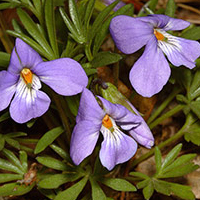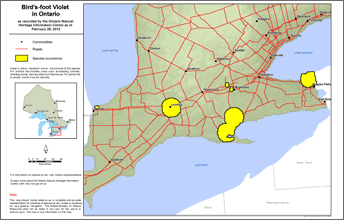Bird’s-foot violet
Scientific name: Viola pedata

Cover photo credit: Allen Woodliffe
Status
Endangered
“Endangered” means the species lives in the wild in Ontario but is facing imminent extinction or extirpation.
Date added to the Species at Risk in Ontario List
The Bird’s-foot violet was already assessed as endangered when the Endangered Species Act took effect in 2008.
What it looks like
Bird’s-foot Violet is a stemless violet with leaves and flowers arising directly from the rhizome (an underground spreading stem). It is named after its thin, finely divided leaves, the lateral leaflets of which resemble the splayed toes of a bird.
Flowers of this violet have five lilac to purple coloured petals with conspicuous orange stamen tips visible at their center. Some flowers are coloured similarly to those of the commonly cultivated pansy (V. tricolor) in that the two upper petals are much darker purple than the rest.
This violet blooms in the spring and sometimes again in the autumn. It produces many tiny, copper-coloured seeds.
Where it lives
In Ontario, Bird’s-foot Violet is found only in black oak savanna, a very rare vegetation type having widely spaced open-grown trees with an understorey of tallgrass prairie herbs.
Natural disturbances caused by drought or fire are important for removing trees and shrubs that would otherwise shade out the tiny Bird’s-foot Violet.
Where it’s been found in Ontario
In Canada, Bird’s-foot Violet is found only in southern Ontario at a handful of sites. In 2001, the population was estimated to be fewer than 7,000 plants at only five locations.
View a Larger version of this map (PDF)
What threatens it
The main threat to Bird’s-foot Violet is lack of suitable habitat. The violet is found in one of the most developed parts of the country and the oak savanna habitat it requires is very rare.
Existing populations require habitat management including prescribed burns to replace the natural wild fire regimes (patterns of fire that occur over long periods of time) to prevent trees and shrubs from taking over Bird’s-foot Violet habitat in southern Ontario.
Action we are taking
Endangered Species and their general habitat are automatically protected
Recovery strategy
A recovery strategy advises the ministry on ways to ensure healthy numbers of the species return to Ontario.
Read the executive summary (November 22, 2013)
Read the recovery strategy (November 22, 2013)
Government response statement
A government response statement outlines the actions the government intends to take or support to help recover the species.
Read the government response statement (December 15, 2014)
Review of progress
A review of progress made toward protecting and recovering a species is required no later than the time specified in the species’ government response statement, or not later than five years after the government response statement is published if no time is specified.
Read the report on progress towards the protection and recovery of 16 species at risk, including Bird’s-foot violet (Viola pedata) (2019).
Habitat protection
General Habitat Protection - June 30, 2008
What you can do
Report a sighting
- The Ministry of Natural Resources and Forestry tracks species at risk such as the Bird’s-foot Violet. Report a sighting of an endangered animal or plant to the Natural Heritage Information Centre. Photographs with specific locations or mapping coordinates are always helpful.
Volunteer
- Volunteer with your local nature club or provincial park to participate in surveys or stewardship work focused on species at risk.
Be a good steward
- Private land owners have a very important role to play in species recovery. If you find Bird’s-foot violet on your land, you may be eligible for stewardship programs that support the protection and recovery of species at risk and their habitats.
- Bird’s-foot Violet and many other species at risk depend on healthy grassland prairies, a habitat that is very rare in Ontario. Learn more about this habitat, the species that depend on it, and what you can do to help.
- Pollinators, such as bees, are in steep decline across the globe and they play a key role in the survival of many of Ontario’s rare plants. For more information on how you can help scientists monitor pollinator populations in Ontario visit Seeds of Diversity.
- Invasive species seriously threaten many of Ontario’s species at risk. To learn what you can do to help reduce the threat of invasive species, visit:
Report illegal activity
- Report any illegal activity related to plants and wildlife to
1-877-TIP-SMNR (847-7667) .
Quick facts
- Bird’s-foot Violet has a creative way to disperse seeds. The tiny seeds are contained inside a smooth green seedpod that bursts open and flings the seeds up to five metres away.
- Ants help to further scatter the seeds by carrying them back to their nests, and eating the outer casing but not the seed itself.
- The Bird’s-foot Violet is an important food source for several species of butterflies.
